


<
>
PHOTONIC HYBRIDS AND NANOMATERIALS GROUP
Aveiro-Portugal
university of aveiro
theoria poiesis praxis
physics department
ciceco
aveiro institute of materials


HOME > SCIENTIFIC OUTPUT > PROJECTS > WINLED

Designação do projeto |
WINLEDs – Díodos emissores de luz (LEDs) branca, inovadores, sintonizáveis e sustentáveis
Código do projeto |
Objetivo principal|
Entidade beneficiária |
CENTRO-01-0145-FEDER-030351
Reforçar a investigação, o desenvolvimento tecnológico e a inovação
Universidade de Aveiro (UA)

Data de início | 01-07-2018
Data de conclusão | 30-06-2021
Custo total elegível |221 013.00€
Objetivos
O recente desenvolvimento dos díodos emissores de luz (LEDs) branca conduziram ao mais rápido crescimento na história da indústria de iluminação. Hoje em dia, além da iluminação interior e exterior, a tecnologia de iluminação de estado sólido (SSL) está, também, penetrando profundamente em outros segmentos de mercado, como iluminação automóvel, aplicações médicas e produtos associados ao estilo de vida das sociedades modernas. Os atuais desafios em SSL abrangem alta eficiência luminosa, estabilidade cromática, índice de restituição de cores (CRI) melhorado, temperatura de cor (CCT) ajustável a um custo competitivo. Recentemente, o desenvolvimento de materiais fotoluminescentes a baixo custo e capazes de, de forma eficiente, converter radiação ultravioleta/azul numa emissão de cor branca tem sido largamente investigado. Neste projeto, propomos o desenvolvimento e caracterização de novos protótipos de LEDs cuja emissão de luz branca é caracterizada por valores melhores de CRI e CCT, em comparação com os do atual LED branco disponível comercialmente, sendo, por isso, uma solução de iluminação mais próxima da luz natural. Para atingir este objetivo, serão seguidas duas estratégias, nomeadamente o desenvolvimento de novos materiais híbridos orgânicos-inorgânicos emissores de banda larga, não tóxicos, feitos a partir de matérias abundantes, baratas e de fácil reciclagem, processados na forma de partículas de dimensões nanométricas e híbridos orgânicos e inorgânicos incorporando iões lantanídeos emissores na região do vermelho, verde e azul (RGB) processados como filmes finos.
Os materiais híbridos serão depositados na superfície de LEDs comerciais que emitem radiação ultravioleta que será absorvida e convertida em luz branca com elevado brilho, CRI elevado (>90) e CCT sintonizável (3000-6500 K) mimetizando as características da luz solar ao longo do dia solar e em diferentes estações do ano. A possibilidade de produzir LEDs com CRI elevado sem recurso a processos complexos e dispendiosos é uma grande vantagem competitiva e diferenciadora no mercado da SSL, com vista a soluções de iluminação com inovação, design e a qualidade exigida para o pelos mercados atuais de iluminação. Tal contribuirá para a disseminação mais rápida da tecnologia LED em áreas especializadas ligadas a projetos de design de interiores e artísticos (ex. cinema, fotografia, galerias de arte). Acresce que a possibilidade de sintonizar a CCT destes novos LEDs potencia, também, a sua aplicação em outras áreas, como no controlo do ritmo circadiano humano, de animais e plantas, com impacto no estado fisiológico e na determinação dos padrões de atividade cerebral e regeneração celular.
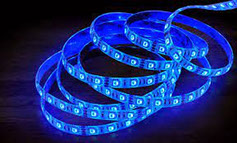
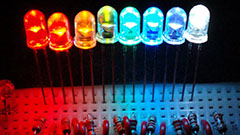
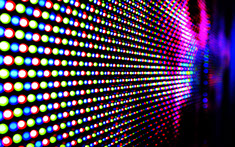
CApÍTULOS DE LIVRO
AR Bastos, PS André, LD Carlos, RAS Ferreira. Green photonics integrated circuits based on organic-inorganic hybrids., Book chapter from Nanocomposites for photonic and electronic applications. Chapter 9, Elsevier, (2020), em Sol-gel derived optical and photonic materials, edited by Elsevier, editores: Rui Almeida, Alex Martucci, L. Santos and Rocio Hernandez.
ARTIGOS EM REVISTAS
Ming Fang, Albano N. Carneiro Neto, Lianshe Fu, Rute A. S. Ferreira, Verónica de Zea Bermudez and L. D. Carlos, A hybrid materials approach for fabricating efficient WLEDs based on di-ureasils doped with carbon dots and a europium complex, Adv. Mater. Technol. 2021, 2100727, https://dx.doi.org/10.1002/admt.202100727.
Biju Francis, Mariela M. Nolasco, Paula Brandão, Rute A. S. Ferreira, Rafael S. Carvalho, Marco Cremona, and Luís D. Carlos, Efficient visible-light-excitable Eu3+ complexes for red organic light-emitting diodes, Eur. J. Inorg. Chem. 2020, 1260–1270, https://dx.doi.org/10.1002/ejic.202000027.
Ming Fang, Lianshe Fu, Sandra F. H. Correia, Rute A. S. Ferreira and Luís D. Carlos, Highly efficient luminescent polycarboxylate lanthanide complexes incorporated into di-ureasils by an in-situ sol-gel process, Polymers 2018, 10, 434, https://dx.doi.org/10.3390/polym10040434.
Ming Fang, Lianshe Fu, Rute A. S. Ferreira and Luís D. Carlos, White-light emitting di-ureasil hybrids, Materials 2018, 11, 2246, https://dx.doi.org/10.3390/ma11112246.
Airton G. Bispo-Jr, Sergio A. M. Lima, Luís D. Carlos, Ana M. Pires, and Rute A. S. Ferreira, Eu(II)-activated silicates for UV light-emitting diodes tuning into warm white light, Adv. Eng. Mater. 2020, 22, 2000422, https://dx.doi.org/10.1002/adem.202000422.
Shikao Shi, Lina Wang, Ming Fang, Lianshe Fu, Luís D. Carlos, Rute A. S. Ferreira, Jiye Wang, Shuping Wang, Blue-light excitable La2Ce2O7:Eu3+ red phosphors for white light-emitting diodes, J. Alloys Compd. 2020, 814, 152226, https://dx.doi.org/10.1016/j.jallcom.2019.152226.
Airton G. Bispo-Jr, Sergio A. M. Lima, Luís D. Carlos, Rute A. S. Ferreira, and Ana M. Pires, Red-emitting coatings for multifunctional UV/red emitting LEDs applied in plant circadian rhythm control, ECS J. Solid State Sci. Technol. 2020, 9, 016008, https://dx.doi.org/10.1149/2.0122001JSS.
Airton G. Bispo-Jr, Sergio A. M. Lima, Luís D. Carlos, Rute A. S. Ferreira, Ana M. Pires, Phosphor-based green-emitting coatings for circadian lighting, J. Lumin. 2020, 224, 117298, https://dx.doi.org/10.1016/j.jlumin.2020.117298.
Sandra F. H. Correia, Ricardo L. Fernandes, Lianshe Fu, Mariela M. Nolasco, Luís D. Carlos, and Rute A. S. Ferreira, High emission quantum yield Tb3+‐activated organic‐inorganic hybrids for UV‐down‐shifting green light‐emitting diodes, Eur. J. Inorg. Chem. 2020, (18), 1736–1742, https://dx.doi.org/10.1002/ejic.202000054.
Ming Fang, Airton G. Bispo-Jr, Lianshe Fu, Rute A.S. Ferreira, Luís D. Carlos, Efficient green-emitting Tb-doped di-ureasil coating phosphors for near-UV excited light-emitting diodes, J. Lumin. 2020, 219, 116910, https://dx.doi.org/10.1016/j.jlumin.2019.116910.
Thays C. F. Santos, Rebeca R. Rodrigues, Sandra F. H. Correia, Luís D. Carlos, Rute A. S. Ferreira, Celso Molina, Laura O. Péres, UV-converting blue-emitting polyfluorene-based organic-inorganic hybrids for solid state lighting, Polymer 2019, 174, 109–113, https://dx.doi.org/10.1016/j.polymer.2019.04.042.
A. R. Bastos, B. McKenna, T. Silvério, L. D. Carlos, P. S. André, R. C. Evans, & R. A. S. Ferreira, Flexible photoluminescent waveguide amplifiers to improve visible light communication platforms. IET Optoelectronics, 2020, 14(6), 356-358, https://dx.doi.org/10.1049/iet-opt.2020.0026.
Ana Bastos, Barry McKenna, Mário Lima, Paulo S. André, Luís D. Carlos, Rachel C. Evans, and Rute A. S. Ferreira, Flexible optical amplifier for visible-light communications based on organic-inorganic hybrids, ACS Omega 2018, 3, 13772−13781, https://dx.doi.org/10.1021/acsomega.8b01726.
Ana R. Bastos, Guanpeng Lyu, Tiago Silvério, Paulo S. André, Rachel C. Evans, and Rute AS Ferreira. Flexible blue-light fiber amplifiers to improve signal coverage in advanced lighting communication systems, Cell Reports Phys. Sci. 2020, 1(4), 100041, https://dx.doi.org/10.1016/j.xcrp.2020.100041.
João F. C. B. Ramalho, Sandra F. H. Correia, Lianshe Fu, Lara L. F. António, Carlos D. S. Brites, Paulo S. André, Rute A. S. Ferreira, and Luís D. Carlos, luminescence thermometry on the route of the mobile-based internet of things (IoT): How smart QR codes make it real, Adv. Sci. 2019, 6, 1900950, https://dx.doi.org/10.1002/advs.201900950.
Sandra F. H. Correia, Ana R. N. Bastos, Lianshe Fu, Luís D. Carlos, Paulo S. André, and Rute AS Ferreira. Lanthanide-based downshifting layers tested in a solar car race, Opto-Electronic Advances, 2019, 2 (6), 190006, https://dx.doi.org/10.29026/oea.2019.190006.
PROTÓTIPOS

a) Emission spectra, and photographs, of the commercial LED and of the Eu3+-doped La2Ce2O7 red-emitting LEDs operating under forward-bias current of 2010-3 A; b) CIE chromaticity diagram (1931) showing the (x,y) emission chromaticity coordinates of original and coated LEDs.
a) Room temperature emission spectra of S1 to S5 WLEDs. The inset shows photographs of the devices. b) Relationship between CCT and CRI and the amount of blend phosphors used (the lines are visual guides).
a) Photographs of the operating LEDs prototypes with different composition; the CCT, the CRI, the LE of the LEDs, and the LER are also listed for each device, b) emission spectra, and c) 1931-CIE coordinate diagram of the LED prototypes operating at 3.1 V
(a) Emission spectra dependence on the operating voltage of the 365-B LED. The inset shows a photograph of the 365-B LED. (b) (x,y) 1931 CIE coordinate dependence on the operating voltage compared to the region required for traffic signals (region delimited by black lines) and automotive device (blue shadowed region) application.
Photograph of the green-emitting LED prototypes: near-UV SMD LEDs (number of LEDs = 35) coated with tU5Tb in a printed circuit board and operating at 20 mA
Photographs of a free standing film of 30TbSal@dU6 under (a) day light and (b) near-UV radiation (365 nm); In (c) a commercial NUV-LED chips (365 nm) coated with 30TbSal@dU6 is shown (the grey dashed circle signs the hybrid coating), whereas the photo in (d) zooms the LED operating at 510-3 A of driving current.
(a) CIE chromaticity diagram showing the (x,y) emission colour of d-U(600)PF1(circle), d-U (600)PF5 (triangle), d-U(600)PF10 (diamond) and d-U(600)PF20 (square) excited at 365 nm and (b) of d-U(600)PF5 as function of the excitation wavelength indicated for each data point, in nm; (c) radiant power spectrum of the best performance device; (d) CIE chromaticity diagram showing the (x,y) emission colour of the fabricated LED operating on 3.5 V, 20 mA. The inset shows a photograph of the LED.
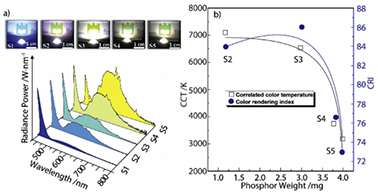
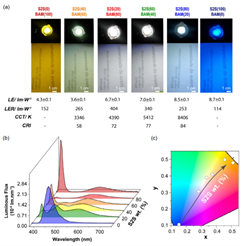
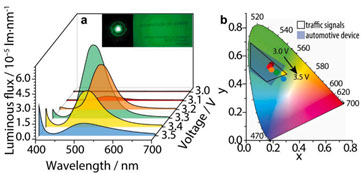
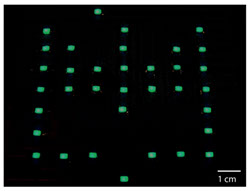
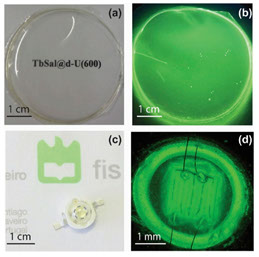

MADE BY PHANTOM-G, AVEIRO, PORTUGAL
